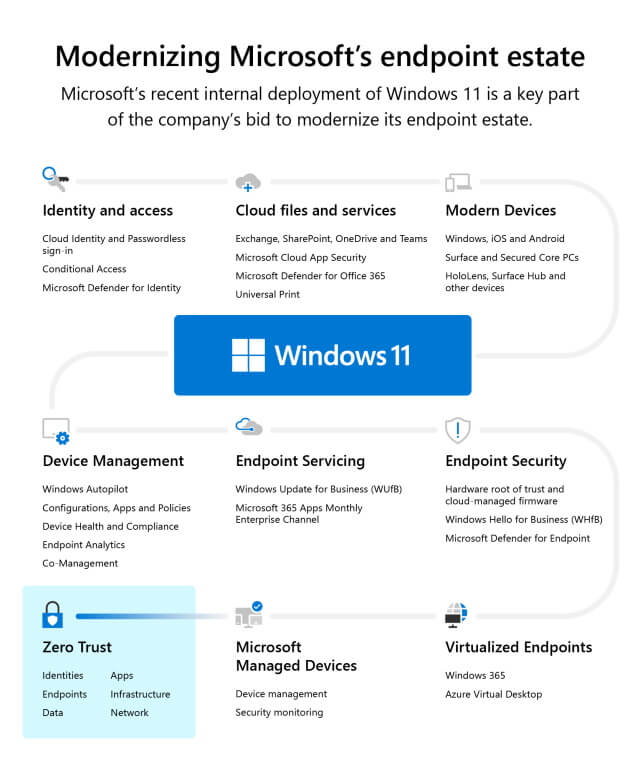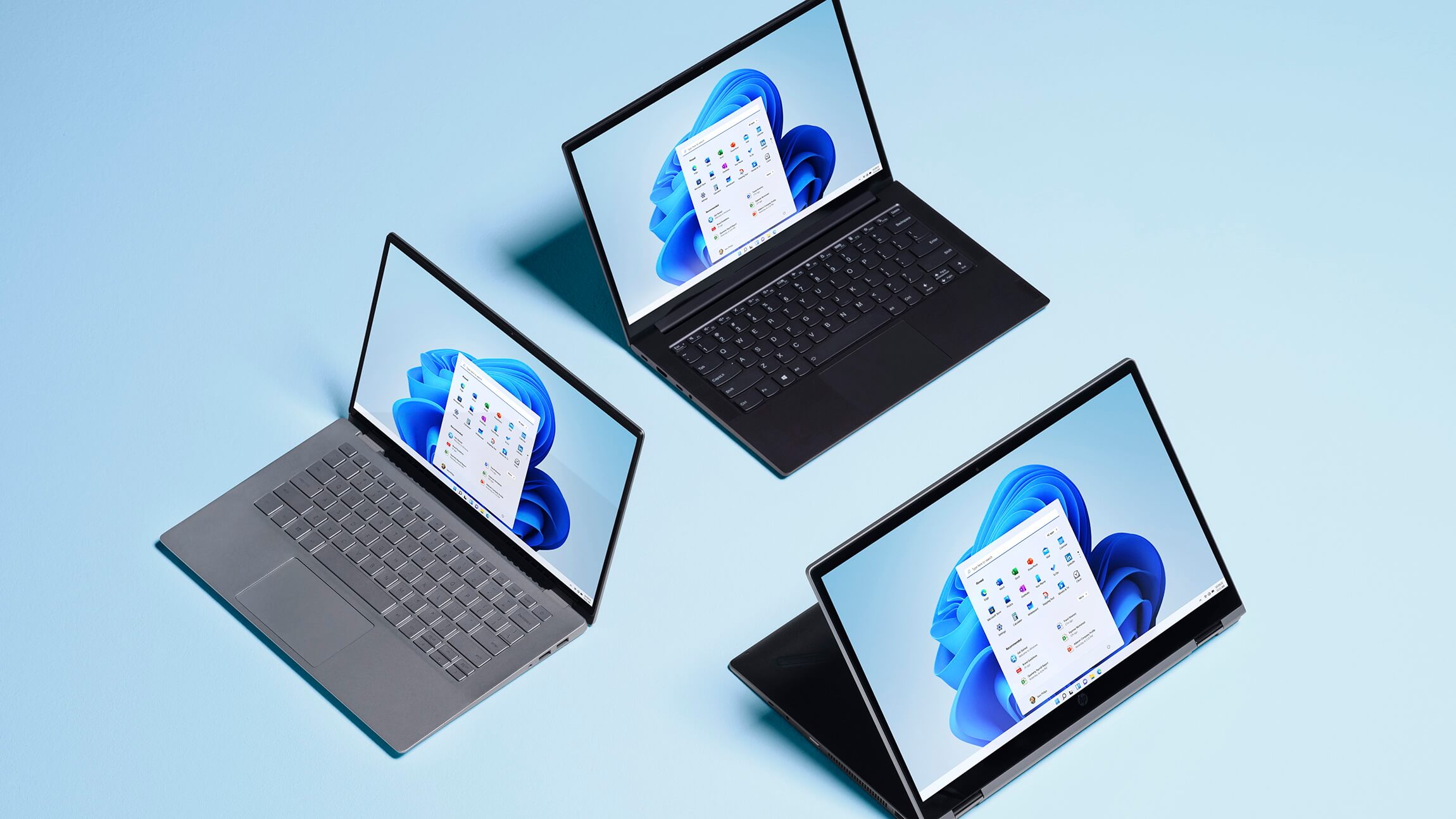 [Editor’s note: This content was written to highlight a particular event or moment in time. Although that moment has passed, we’re republishing it here so you can see what our thinking and experience was like at the time.]
[Editor’s note: This content was written to highlight a particular event or moment in time. Although that moment has passed, we’re republishing it here so you can see what our thinking and experience was like at the time.]
Microsoft’s recent deployment of Windows 11 to 190,000 devices across the company is enabling its employees to work smarter and stay better connected.

Microsoft Digital Employee Experience, the organization that powers, protects, and transforms the company, completed the rollout in five weeks—the fastest deployment of an operating system in company history—without disruption.
“When you look at the data, our time to deploy and the number of support contacts, Windows 11 is the most successful Windows deployment in our history,” says Nathalie D’Hers, Microsoft’s corporate vice president of Microsoft Digital Employee Experience. “For a major release, it was so straightforward and fast that it was almost a non-event. Windows 11 raises the bar for all future deployments.”
Getting Windows 11 to employees in a fast, hassle-free way was crucial. Ensuring rollouts are free of disruption makes a big difference for Microsoft employees and—because employee feedback gets rolled into the products—for customers.
A device is your connection to your work experience, especially when you can’t go into the office. Your device shouldn’t get in the way of what you’re doing, so we wanted to make sure our employees had a good upgrade experience.
—Nathalie D’Hers, corporate vice president, Microsoft Digital Employee Experience
“Microsoft employees are very vocal when it comes to giving us feedback about our products and features and that’s a good thing,” D’Hers says. “If the product isn’t working well, we hear about it early on, and that wasn’t the case this time. When we deployed Windows 11, we received very few requests for support—that’s an important indicator of product quality for us.”
Making deployment seamless for employees
A good Windows deployment is frictionless, where employees are not inconvenienced or prohibited from using their devices, apps, or important features.
“A device is your connection to your work experience, especially when you can’t go into the office,” D’Hers says. “Your device shouldn’t get in the way of what you’re doing, so we wanted to make sure our employees had a good upgrade experience.”
The experience of moving from Windows 10 to Windows 11 was so smooth, it felt more like an update than an upgrade.
—Sean MacDonald, partner director of program management, Microsoft Digital Employee Experience

- Microsoft tries Windows 11 on for size and likes the fit (this blog post)
- Unpacking Microsoft’s speedy upgrade to Windows 11
- Windows 11 boosts employee engagement at Microsoft
- Employees are at the heart of Microsoft’s internal Windows 11 upgrade
- Five key learnings from Microsoft’s Windows 11 upgrade
The Microsoft Digital Employee Experience team knew improvements in Windows 11, including an intuitive and improved user interface, would help employees stay connected and work smarter. That made a straightforward deployment—where critical business applications weren’t risked and security wasn’t compromised—even more important.
“It always starts with the user, the employee, the person—that’s who we center around,” says Sean MacDonald, partner director of program management with the Microsoft Digital Employee Experience team who oversaw the deployment of Windows 11 at Microsoft. “Windows 11 does a great job of taking that perspective, it’s about the user, which is key to our employee experience.”
Helping to make this deployment frictionless were familiar processes that had been utilized for Windows 10 releases. “The experience of moving from Windows 10 to Windows 11 was so smooth, it felt more like an update than an upgrade,” MacDonald says.
There was no disruption to business, just a download that occurred in the background, an alert telling the employee that their device was ready, and a quick restart to finish installing the new operating system. As soon as 20 minutes later, the employee was up and running in Windows 11. The device owner could also schedule the upgrade to take place during non-work hours—when they logged in the next day, they were using the new operating system.
For a transcript, please view the video on YouTube: https://www.youtube.com/watch?v=40B99JJpaUo, select the “More actions” button (three dots icon) below the video, and then select “Show transcript.”Connecting with employees
Communications played a key part in Microsoft’s disruption-free rollout.
Windows 11 has specific hardware requirements, which meant not every device at Microsoft would be part of the deployment.
“Most devices were eligible but letting everyone know about hardware requirements was an early step,” MacDonald says. “Since Windows 10 and Windows 11 work in tandem with no additional overhead, we’re able to seamlessly co-manage both upgraded and non-upgraded devices until all of our older Windows 10 devices are replaced.”
Sharing this fact with employees across Microsoft eased anxieties.
From that point on, it was about sharing clear and concise messaging that encouraged employees to upgrade and provide feedback. Communication plans emphasized empowering employees across Microsoft to submit comments through Feedback Hub, a tool where users can voice and upvote suggestions. Elsewhere, Microsoft support teams readied their own listening systems to resolve queries and to report feedback to the product group.
Even with many channels open, few issues were reported.

“We saw no uptick in support contacts,” MacDonald says. “If the only noise is people talking about features, that’s the sign of a good deployment.”
A better deployment experience
Microsoft Digital Employee Experience encounters many of the same challenges other IT organizations face. But with the deployment of Windows 11, an established playbook of trusted practices along with modern solutions, like Windows Update for Business, converged for a streamlined experience.
A large part of this is due to the Windows Update for Business deployment service.
“It’s truly Windows-as-a-Service,” MacDonald says. “Windows Update for Business deployment service is easy to control, highly compliant, and adoption is straightforward.”
Windows Update for Business deployment service combines two workstreams into one, which sped up Microsoft’s internal deployment of Windows 11. Instead of building separate deployment plans for Microsoft Azure Active Directory (AAD) devices, Windows Update for Business deployment service allowed the team to establish a single strategy for the entire environment. Within the service, Microsoft Digital Employee Experience was able to handle exclusions, automatically stage deployment waves, and bypass devices that were ineligible for the upgrade.
Other tools, like Windows Update for Business reports, further reduced the workload placed on the team. Using Update Compliance, the organization quickly and easily analyzed the device population for hardware eligibility. Data gathered from Update Compliance and Microsoft Endpoint Manager informed Microsoft Digital of a device’s deployment status, giving clear visibility to which ones had moved to Windows 11.
Over the course of five weeks, Microsoft Digital Employee Experience seamlessly rolled out Windows 11 to all eligible employee devices.
Success measured in outcomes
The deployment of Windows 11 represents the right chemistry of technology and expertise working together for a harmonious experience. Employees at Microsoft quickly and easily upgraded to Windows 11 on their schedules. Microsoft Digital Employee Experience utilized tools like Windows Update for Business deployment service to streamline familiar processes.
“We had to target the devices that could run Windows 11, but we have a plan to ramp up and refresh all devices as we go,” MacDonald says. “We have a path to Windows 11 for everyone.”
Windows 11 has done a good job of keeping the user in mind. The aesthetics are simple. The user experience is familiar but improved, making it easier to complete the common tasks and activities I do every day.
—Nathalie D’Hers, corporate vice president, Microsoft Digital Employee Experience
Thanks to its design, Microsoft Digital Employee Experience will be able to easily co-manage Windows 11 and Windows 10 side-by-side. Microsoft designed Windows 11 to ensure backward compatibility with Windows 10, so apps remain compatible, removing another challenge typically found during the release of new operating systems.
The transformation continues
The success of the deployment of Windows 11 validates Microsoft Digital Employee Experience’s approach to new features and product releases, which empowers people to succeed while minimizing disruption.
“Windows 11 has done a good job of keeping the user in mind,” D’Hers says. “The aesthetics are simple. The user experience is familiar but improved, making it easier to complete the common tasks and activities I do every day.”
With new functionality, like snap assist and docking, users can work more efficiently. Device hardware baselines, including a Trusted Platform Module 2.0 (TPM) requirement, enhance the security of devices and create better hardware-to-software integration in Windows 11. Transport Layer Security, an encryption protocol for transferring data over a network, empowers Microsoft Digital Employee Experience to perform IT functions remotely without fear of a compromise.
All of this improves how Microsoft employees can stay safe and productive.
“An important part of our Customer Zero role is to provide our employees and other internal users with the best products and services as early as possible,” D’Hers says.

- The disruption-free deployment of Windows 11 was powered by the same tools and practices Microsoft Digital uses for Windows 10 updates.
- Since Windows 10 and Windows 11 can be co-managed side-by-side, Microsoft intends to let users stay on their current devices until it is time for a refresh.
- Apps that work on Windows 10 work on Windows 11, and a better user interface improves employee experience.
- As customer zero, Microsoft employees take on the role of providing feedback and suggesting improvements from an enterprise perspective.

- Unpacking Microsoft’s speedy upgrade to Windows 11.
- Employees are at the heart of Microsoft’s internal Windows 11 upgrade.
- Windows 11 boosts employee engagement at Microsoft.
- Five key learnings from Microsoft’s Windows 11 upgrade.
- Find out how Microsoft is reinventing the employee experience for a hybrid world.
- Review Windows client documentation for IT Pros.
- Get insights into what the Microsoft Tech Community has to say about deploying Windows 11.
- Learn how to streamline upgrades with Windows Update for Business deployment services.
- Explore how Windows Update for Business keeps devices up to date.
- Discover how Update Compliance improves device configuration.
Tags: digital transformation, Windows








